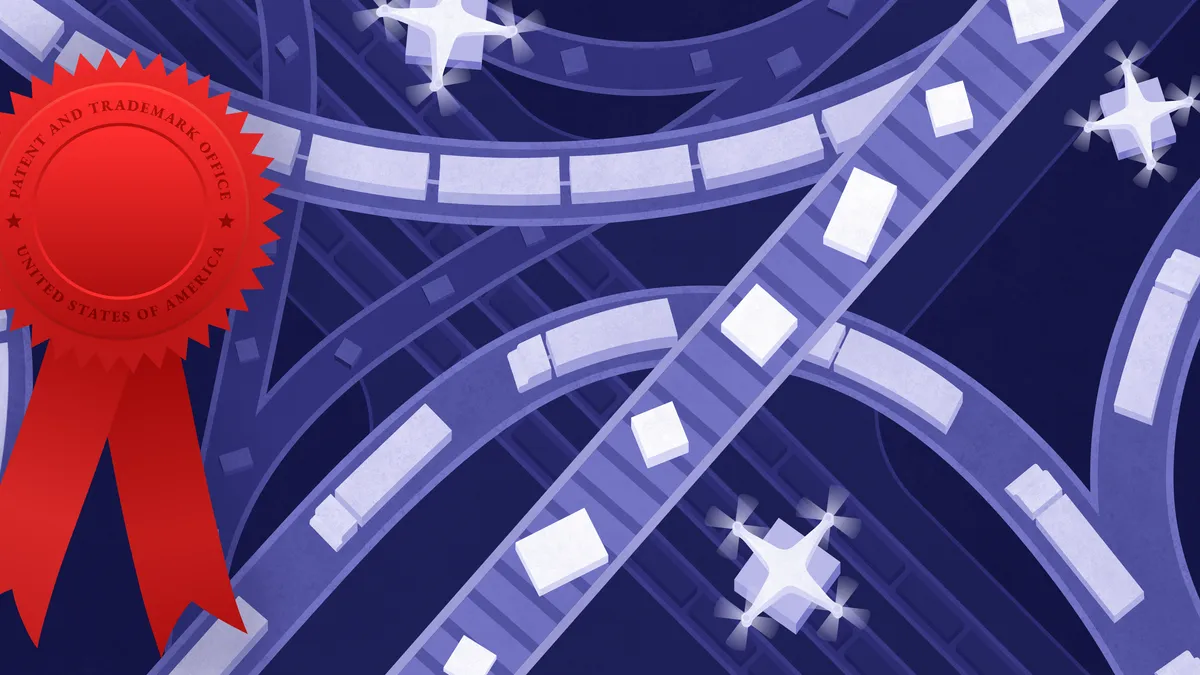This is Patent Pending. Supply chain-related patent applications are published every week and this is where we'll talk about the ones that could have the biggest impact on the supply chain and the ones that challenge the norm. We want to give you an idea of where supply chains are heading and what the industry is thinking. Keep an eye out for this column on Fridays. Read the last issue here.
Where's that forklift? And a camera to handle the cold

There are a variety of vehicles that could buzz around in a modern warehouse from autonomous carts to forklifts.
Knowing where machines are — and where they've been — can help determine the location of inventory, the best routing of vehicles and help coordinate multiple vehicles simultaneously. A patent application filed by cold chain giant Lineage Logistics and published this week provides an idea.
- A stereoscopic camera on the vehicle captures an image.
- Computer vision recognizes various shapes or color properties of "identification markers" in the picture. These markers could include barcodes or QR codes.
- This image is compared to a spatial model of the warehouse, which provides the location.
The application points out the spatial model can be locally maintained, which means it would not require a continuous connection to a network. But network connectivity is not the only challenge addressed by this patent. In refrigerated storage, camera equipment might not function properly. Lineage Logistics suggests outfitting the camera with a lens heater or sealing it to reduce moisture.
Read up:
-
4 types of autonomous mobile robots, and their warehouse use cases
-
Boxed tests driverless carts to improve warehouse efficiency
Figure out fulfillment with an 'online order analyzer'

In the fast-evolving world of e-commerce, one question for businesses is how to best manage inventory in an omnichannel environment.
In the last issue of this column, I wrote about an idea presented by Celect, the data science company acquired by Nike earlier this year, involving inventory routing between store locations. IBM has similar concerns for determining which retail location should fulfill an online order, in an application published this week.
IBM's application focuses on an environment where a retailer uses a distribution center for online orders but also has physical retail locations. The problem IBM is trying to tackle is that of stockouts or running out of a particular item at either the e-commerce fulfillment center or the storefront. IBM proposes a system that can weigh potential "stockout costs" for locations before deciding if an order should be fulfilled through the distribution center or the storefront. The application says this could be especially helpful during peak season periods like Black Friday. The "stockout cost" is a measure of the impact of a potential lost sale at the physical retail location.
IBM called the process the "Online Order Analyzer."
- Receive information on the order.
- Compare against a database that includes the location and inventory levels at the distribution center and retail locations.
- Determine which locations stock the items in the order.
- Run the test to determine the "stockout cost."
- Determine a shipping location.
- Ship the order from that location.
"By utilizing the stockout cost, the online order may be optimally routed to either distribution centers or physical stores for fulfillment so as to minimize or avoid product stockouts," the application reads.
Read up:
-
Patent Pending: Nike's ship-from-store concept, Walmart's autonomous locker
-
Choosing the right fulfillment option is about weighing cost and speed
-
Opinion: Out-of-stocks are more costly than losing a sale — but there's a fix
Getting your robot to come when called

In a previous patent, Walmart laid out its idea for autonomous sortation using autonomous vehicles and a conveyor-belt with computer-controlled rollers to help route packages. In a newly filed patent, Walmart zooms in on one aspect of this process: routing autonomous vehicles.
There are three parts to the system Walmart envisions in this application:
- The scan module.
- The sort module.
- The distribution module.
The scan process will get information on the type of device while the sort module will divide the incoming orders based on the information collected by the scan. Finally, the distribution model will determine the best route for the autonomous vehicle based on the location of other vehicles within the warehouse. In one potential version of the application, the vehicle will deliver the package to a storage tower where it can be picked up by a customer.














